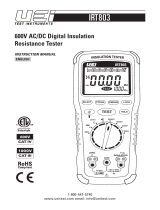
5.1 SAFETY PRECAUTIONS
Warning
To avoid electrical shock or personal injury.
Please read the safety information and “warnings and precautions” before use.
This instrument complies with IEC1010 (International Electrotechnical Commission
promulgated safety standards). Design and production using the pollution level 2 safety
requirements.
Warning: When measuring voltage above 30V, current above 10ma, AC power with an
inductive load. Use caution not to touch exposed contacts due to the risk of electric shock,
only use approved probes or clamps.
1. Before measuring, check whether the measurement function switch is in the correct
position, check whether the test probe is connected correctly to avoid electric shock.
2. The meter is only to be used in conjunction with the supplied test leads to comply with
safety standards. If the test leads are broken or damaged, replace the test leads of the
same type or the same electrical specifications.
3. Do not use an unapproved fuse to replace the fuse inside the meter. Only replace with
the same model or the same specifications of the fuse. Before changing, remove the
test leads to ensure that there is no signal input.
4. Do not use unapproved batteries to replace the battery inside the meter. Replace only
with the same model or the same electrical specifications of the battery. Before
changing, remove the test leads to ensure that there is no signal input.
5. During electrical measurements, the body must not be directly in contact with the
earth, use insulating materials to keep your body insulated from the earth.
6. Do not store or use in high temperature, high humidity, flammable, explosive and
strong magnetic field environments.
7. Measurements exceeding the limit values of the instrument may damage the
instrument and endanger the safety of the operator.
8. Do not attempt to calibrate or service the instrument.
9. When the LCD shows “ ”, please replace the battery.
10. Do not insert the test leads to be inserted into the current terminals to measure the
voltage!
8.6 DIODE TEST
8. OPERATING INSTRUCTIONS
5. HEALTH & SAFETY INFORMATION
1. Connect the black test lead to the " COM " terminal and the red test lead to the
" " terminal. ( Note: The polarity of the red lead is positive " + ". )
2. Set the measurement function range switch to position.
3. If the symbol " " is not shown on the display, press the SEL button until the symbol
" " appears on the the display.
4. Connect the red test lead to the anode of the diode to be tested and the black test lead
to the cathode of the diode.
5. The display shows the approximate forward voltage drop of the diode. If the connection
is reversed, " OL " will be shown on the display.
17
8

























